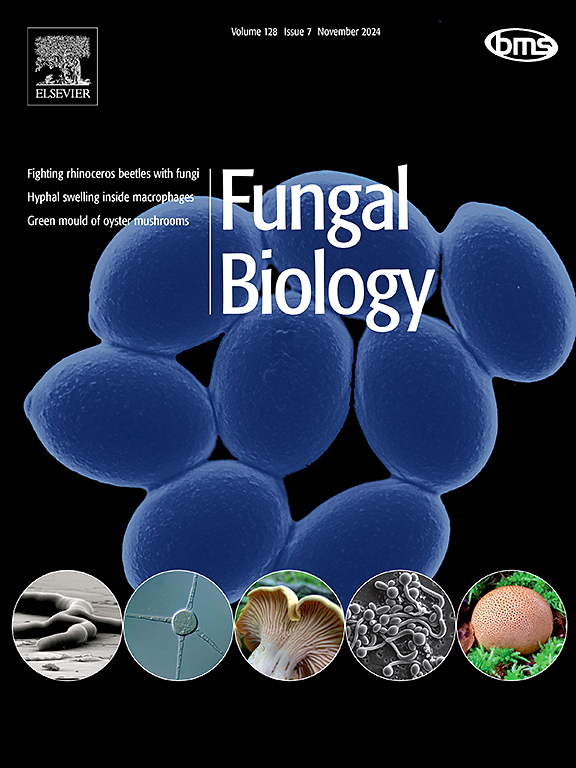Fusarium graminearum regulates kp4l genes, encoding killer toxins, during competitive interaction with other plant pathogenic Fusarium species
IF 2.9
3区 生物学
Q2 MYCOLOGY
引用次数: 0
Abstract
Fusarium graminearum (Fg) is one of the most virulent causal agents of Fusarium head blight (FHB) in Central Europe. The disease is also caused by other Fusarium species within the FHB Species Complex (FHBSC). Some Fusarium species secrete killer proteins (KPs) during host plant infection. Fg produces KP4-L killer toxins (FgKP4L), of which the clustered Fgkp4l-1, -2, -3 genes and Fgkp4l-4 (encoding for the heterodimeric KP4L-4 protein) are expressed in competitive interactions against the biocontrol agent Trichoderma gamsii T6085. We investigated the involvement of the four Fgkp4l genes in the competition with other plant-pathogenic Fusarium species either lacking KP4L proteins or carrying different combinations of them. Fusarium sporotrichioides (Fs) and Fusarium langsethiae (Fl) belonging to the FHBSC, and the outgroup Fusarium verticillioides (Fv), were used for both in vitro and in vivo tests. To monitor mycotoxin production, relative expression of Tri4 gene included within the trichothecene biosynthetic pathway was also evaluated. In dual cultures, modulation of KP4L-encoding genes was tailored according to the facing species and the distance between fungi. Against Fs, the three clustered Fgkp4l genes were up-regulated but no changes on gene expression occurred with Fl. Fgkp4l-2 was up-regulated facing Fv during the two contact independent stages (Early sensing and Sensing) of the interaction. The Tri4 gene was expressed only during the in vitro interaction with Fv, but not on spikes. Fgkp4l-2 and -3 were up-regulated at 3 days post-inoculation on wheat heads inoculated with a mix of the four Fusarium species. Competition against the other Fusarium did not influence Fg growth rate on spikes.
在与其他植物致病性镰刀菌的竞争相互作用中,禾谷镰刀菌调节编码杀伤毒素的kp4l基因
镰刀菌(Fusarium graminearum, Fg)是导致中欧地区镰刀菌头疫病(Fusarium head blight, FHB)最致命的病原之一。该疾病也由FHB物种复合体(FHBSC)内的其他镰刀菌引起。一些镰刀菌在侵染宿主植物时分泌杀伤蛋白(KPs)。Fg产生KP4-L杀伤毒素(FgKP4L),其中聚集的FgKP4L -1、-2、-3基因和FgKP4L -4(编码异二聚体KP4L-4蛋白)在与生物防治剂甘氏木霉T6085的竞争相互作用中表达。我们研究了四个Fgkp4l基因与其他植物致病性镰刀菌物种的竞争,这些物种要么缺乏KP4L蛋白,要么携带不同的KP4L蛋白组合。采用FHBSC属的孢子毛状镰刀菌(Fs)和langsethiae镰刀菌(Fl)以及外群verticillioides镰刀菌(Fv)进行体外和体内试验。为了监测霉菌毒素的产生,我们还对菌毛菌生物合成途径中包含的Tri4基因的相对表达量进行了评估。在双重培养中,根据面对的物种和真菌之间的距离调整kp4l编码基因的调节。Fgkp4l-2在相互作用的两个不依赖于接触的阶段(Early sensing和sensing)面对Fv时表达上调。Tri4基因仅在体外与Fv相互作用时表达,而在刺突上不表达。4种镰刀菌混合接种后3 d, Fgkp4l-2和-3在小麦穗上表达上调。与其他镰刀菌的竞争不影响镰刀菌在穗上的生长速度。
本文章由计算机程序翻译,如有差异,请以英文原文为准。
求助全文
约1分钟内获得全文
求助全文
来源期刊

Fungal biology
MYCOLOGY-
CiteScore
5.80
自引率
4.00%
发文量
80
审稿时长
49 days
期刊介绍:
Fungal Biology publishes original contributions in all fields of basic and applied research involving fungi and fungus-like organisms (including oomycetes and slime moulds). Areas of investigation include biodeterioration, biotechnology, cell and developmental biology, ecology, evolution, genetics, geomycology, medical mycology, mutualistic interactions (including lichens and mycorrhizas), physiology, plant pathology, secondary metabolites, and taxonomy and systematics. Submissions on experimental methods are also welcomed. Priority is given to contributions likely to be of interest to a wide international audience.
 求助内容:
求助内容: 应助结果提醒方式:
应助结果提醒方式:


